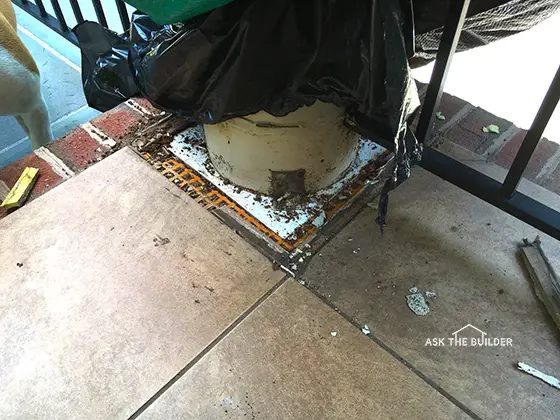Water Leak Under Porch

Water Leak Under Porch | This is the base of a wood column that sits on a wood-framed porch exposed to the weather. Water is leaking causing the wood to rot. © 2017 Tim Carter
DEAR TIM: I’ve got water leaking and infiltrating the underside of my front porch. My house is about ten years old. The porch has a roof over it with a decent overhang, but the floor system is regular wood joists covered with plywood. The contractor installed a waterproof layer over the plywood, then ceramic tile filled with urethane grout. The ceramic tile overlaps row-lock brick at the edges of the porch. What could have possibly gone wrong and how can it be fixed? How would you have built this porch if you were the builder? Steve G., Ellicott City, MD
DEAR STEVE: I’m really sorry you’re having these water leak issues with your front porch. You’ve got a real mess on your hands and I’m afraid I’ve got distressing news from you based on all the photos you sent me. You’re going to have to demolish everything and start over.
I’m fortunate to be old enough to have worked on many older homes that had wood front porches that stood the test of time and were built somewhat similar to yours. The big difference was the materials used and the method of construction. In fact, the second home I owned had a wood front porch. This house was about eighty years old when I purchased it and the porch had virtually no rot even though it was open on three sides and had a roof overhang similar to yours.
The reason why my porch lumber didn’t rot was because the wood for the porch decking was tongue and groove vertical grain wood that not only sloped away from the house, but the individual boards were also installed so the interlocking tongues and grooves pointed away from the house. These decking boards overhung the porch fascia and framing by about 3 inches.
The wood joists under the porch and the tongue and groove decking were old-growth timber that had about a 50-50 ratio of summer wood to spring wood. This high concentration of dense dark-grained summer wood made the wood very rot resistant. The wood decking was also painted and the paint was always kept in good shape.
The wood used to build your home and front porch deck has been hybridized so it grows fast. As such it has a much higher concentration of the lighter-colored spring wood in the annual growth bands. This spring wood is very susceptible to wood rot because it’s not nearly as dense as the dark summer wood. The darker bands of summer wood are so dense they have a hard time absorbing water.
I feel the contractor who built your porch didn’t have a full understanding of how water migrates through and around building materials. At the very least, the plywood deck should have been covered with the best ice and water shield product that seals to itself and just about anything it touches once it heats up. This membrane needed to lap up on the walls of the house next to the porch and then lap over the finished exterior wall surfaces below the porch. Properly installed this membrane would have created a waterproof barrier over the wood framing system.
So long as the wood-framed porch had a slope built into it allowing it to shed water to the outside of the building, any water that penetrated through the tile floor, around the waterproof substrate under the tile and around the large corner support column would have just eventually made it to the outside and never touched the wood. But don’t underestimate how hard it is to install a membrane like this and have it work.
You also were inviting all sorts of issues with any connections between porch railing supports and the porch floor. Each one of these is a possible entry point for water.
While it’s impossible in this small amount of space to share all construction details, had I been the builder on the job I would have tried to convince you to install a properly flashed poured concrete porch floor that rested on masonry foundation walls on all sides of the porch. The technology to do this and prevent water infiltration into the storage space below has been known for decades. The house I grew up in had a poured concrete porch with a roof over it. It was exposed on three sides and the storage room below never had a drop of water in it.
If you resisted using concrete, then I would have insisted that the entire wood system that was installed be all treated lumber, including the plywood decking. As you know, treated lumber can resist wood rot quite well. Many people are unaware that you can purchase sheets of treated plywood. It’s readily available at traditional lumber yards near you.
The porch would have had a slope to it so any water that hits the plywood drains away from the house. I would have made sure the waterproof membrane that was applied to the plywood overlapped another waterproof membrane that was on any wood-framed walls that might support the porch floor. Picture how a traditional asphalt shingle roof works where one shingle overlaps another and works with gravity to keep a house dry. You need to do the same thing to waterproof any wood-framed structure including walls and floors.
The final finished flooring of the porch would have been installed and it would have overlapped the exterior lower section of the porch by 3 inches. I would have made sure there was a drip kerf in the underside of the overhanging material so water would not run back to the vertical walls.